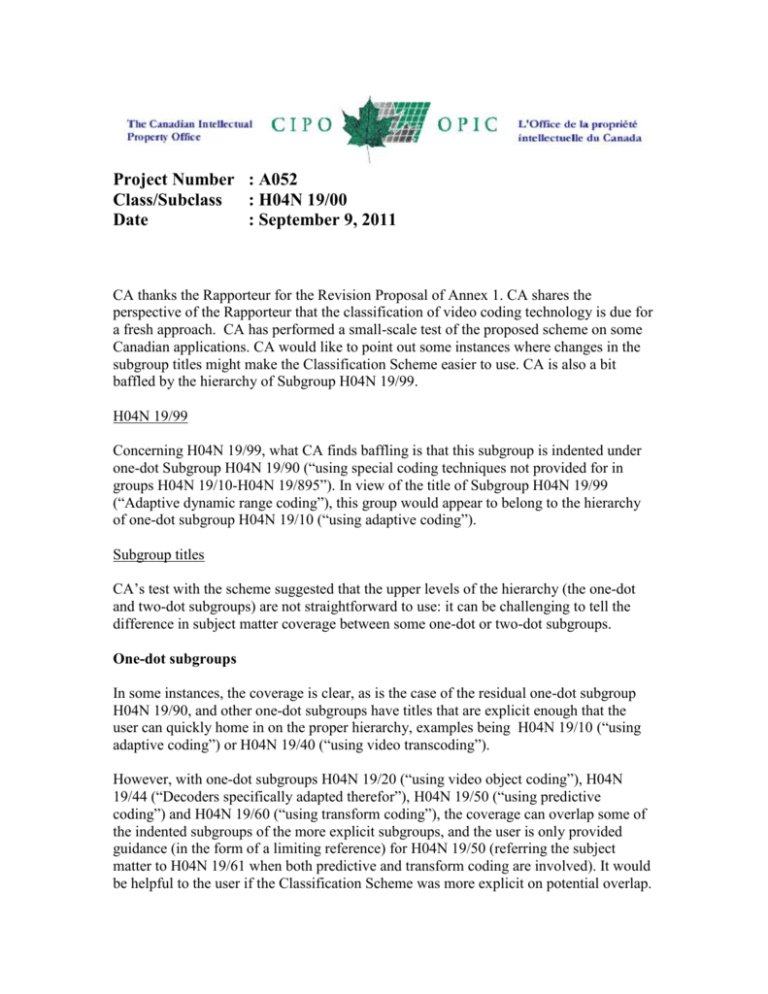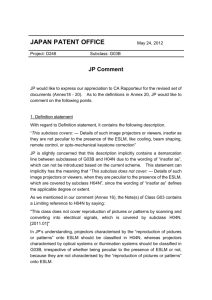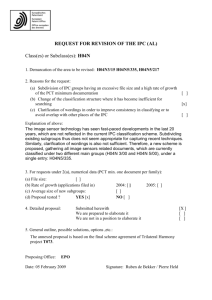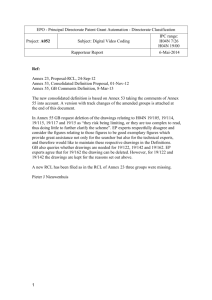2 - WIPO
advertisement

Project Number : A052 Class/Subclass : H04N 19/00 Date : September 9, 2011 CA thanks the Rapporteur for the Revision Proposal of Annex 1. CA shares the perspective of the Rapporteur that the classification of video coding technology is due for a fresh approach. CA has performed a small-scale test of the proposed scheme on some Canadian applications. CA would like to point out some instances where changes in the subgroup titles might make the Classification Scheme easier to use. CA is also a bit baffled by the hierarchy of Subgroup H04N 19/99. H04N 19/99 Concerning H04N 19/99, what CA finds baffling is that this subgroup is indented under one-dot Subgroup H04N 19/90 (“using special coding techniques not provided for in groups H04N 19/10-H04N 19/895”). In view of the title of Subgroup H04N 19/99 (“Adaptive dynamic range coding”), this group would appear to belong to the hierarchy of one-dot subgroup H04N 19/10 (“using adaptive coding”). Subgroup titles CA’s test with the scheme suggested that the upper levels of the hierarchy (the one-dot and two-dot subgroups) are not straightforward to use: it can be challenging to tell the difference in subject matter coverage between some one-dot or two-dot subgroups. One-dot subgroups In some instances, the coverage is clear, as is the case of the residual one-dot subgroup H04N 19/90, and other one-dot subgroups have titles that are explicit enough that the user can quickly home in on the proper hierarchy, examples being H04N 19/10 (“using adaptive coding”) or H04N 19/40 (“using video transcoding”). However, with one-dot subgroups H04N 19/20 (“using video object coding”), H04N 19/44 (“Decoders specifically adapted therefor”), H04N 19/50 (“using predictive coding”) and H04N 19/60 (“using transform coding”), the coverage can overlap some of the indented subgroups of the more explicit subgroups, and the user is only provided guidance (in the form of a limiting reference) for H04N 19/50 (referring the subject matter to H04N 19/61 when both predictive and transform coding are involved). It would be helpful to the user if the Classification Scheme was more explicit on potential overlap. For example, when predictive coding is found as part of a more specific system (for example, within adaptive coding, as in H04N 19/1202 to H04N 19/1215), is that subject matter also classified in H04N 19/50 (multi-aspect classification), or is the classification limited to the hierarchy of H04N 19/10? Worded differently, does the Rapporteur intend the more functional places like H04N 19/50 and H04N 19/60 to be comprehensive or to cover patent documents that are not accommodated into the more application-oriented subgroups? Another example would be H04N 19/44 (“Decoders specifically adapted therefor”). Based on its classification rules, CA would use that one-dot subgroup on every patent document where a claim is directed to a video decoder. Two-dot subgroups At the two-dot subgroup level, CA found difficult to grasp precisely the distinction between subgroups H04N 19/12 and H04N 19/14. One difficulty is that the word “adaptivity” is not defined in any of the dictionaries (electronic or book form) that CA consulted. (Obviously, this could be solved using the “Glossary” part of the Definition, when that stage is reached.) Because there are indented subgroups with similar subject matter indented under two-dot subgroups H04N 19/12 and H04N 19/14 (in particular, H04N 19/1202 vs H04N 19/146; and H04N 19/1208 vs H04N 19/1463), it would be very helpful to the IPC user if the titles of groups H04N 19/12 and H04N 19/14 pointed more clearly to the distinction between the two hierarchies. CA notes firstly that both two-dot subgroups use the singular form for the words “element” and “parameter”, whereas the plural “criteria” is used in H04N 19/14. Is that distinction intended? For example, if a patent document involved a plurality of parameters or elements, should H04N 19/12 or H04N 19/14 be avoided? Secondly, while testing the proposed scheme, CA found the title of Subgroup H04N 19/12 difficult to interpret on its own, and resorted to a two-step process of eliminating Subgroup H04N 19/14 before considering Subgroup H04N 19/12 and its hierarchy. It would be more efficient for the user if classification in the hierarchy of H04N 19/12 could be based on a positive determination, rather than an elimination process. If CA understands correctly the intention of the Rapporteur, the hierarchy of subgroup H04N 19/12 would cover patent documents where the inventive aspect is in transforming (through adaptive coding) an element, or in changing a parameter of the coding process, or in altering the coding process itself, whereas the hierarchy of Subgroup H04N 19/14 would cover patent documents where the inventive aspect pertains to the element, parameter or process controlling the coding process. If that is so, some slight rewording of the titles of these two-dot subgroups might make the distinction clearer. A (nonexhaustive) list of options is given below: H04N 19/12 characterised by the transformation occurring to an element, parameter or a selection during the adaptive coding characterised by an element, parameter or selection altered during the adaptive coding characterised by an element, parameter or selection affected, i.e. controlled, by the adaptive coding characterised by the element, parameter or selection acted upon during the adaptive coding H04N 19/14 characterised by an element, parameter or criterion controlling the adaptive coding characterised by a controlling element, parameter or criterion characterised by an element, parameter or criterion affecting, i.e. controlling, the adaptive coding Also at the two-dot subgroup level, CA finds the subject matter of Subgroup H04N 19/16 difficult to circumscribe. The expression “the coding unit” covers many different pictorial entities, as inferred from the titles of Subgroups H04N 19/161 to H04N 19/169, and seems therefore to have a very broad meaning. Hence, CA wonders if the subject matter of Subgroup H04N 19/164 could not always be accommodated under Subgroup H04N 19/1255. CA would have the same concern for the subject matter of Subgroup H04N 19/162, which would appear suitably covered in Subgroup H04N 19/1232. (The clause “characterised by the structural or semantic portion of the video signal being the object or the subject of the adaptive control during the coding” did not enlighten CA; in particular, CA could not figure out what distinction was intended between “object” or “subject” with respect to the adaptive control.) CA would like to emphasise that it welcomes the proposal of the Rapporteur for a revision of the video coding area. The problem that CA faces is in avoiding an overload of classification places on patent documents pertaining to video coding. Claude Plante Senior Patent Classification Examiner John Dowding Senior Patent Classification Examiner








